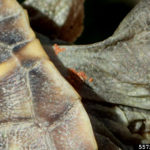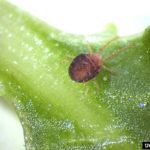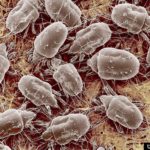
Infestation of chiggers (orange patch) on neck of hatchling ornate box turtle. Image by Whitney Cranshaw, Colorado State University, Bugwood.org
Although mites are not insects they often get grouped in with a vast assortment of urban insect pests. Mites are actually arachnids rather than insects since they have 8 legs (as adults) and two body regions as opposed to the six legs and three body regions that insects have.
Mites are one of the most abundant groups of organisms on the earth. Beneficial mites include species that break down organic matter and predators of pest insects and other mites.
While most mites carry out their business quietly without disturbing anyone, the mites that get attention are the ones that cause problems. The troublemakers (as far as humans are concerned) can generally be divided into two groups: those that are pests in homes/buildings such as stored product and dust mites which are a nuisance but are not directly parasites of humans, and mites that bite or are parasites of humans. Since mites are such a large group, this article will discuss a few common mite pests you may encounter at schools.
Chiggers
Chiggers are the larvae, or immature stage, of the trombiculid mites. The term “chigger” is the most common name of this annoying mite but you might know them as {harvest mites, harvest bugs, harvest lice, mower’s mites, or red bugs}, but this mite prefers to attack human, our domestic animals and wild animals that frequent our neighborhoods. These larval mites climb onto people when they walk through chigger-infested areas. The chiggers wander around the body for a

Chigger Mite (Trombicula spp.)
while, seeking a good site to feed. They prefer to feed in areas where skin is thinnest or where clothing fits tightly, such as the ankles, waist, behind the knees and groin.
Chiggers do not burrow into the skin as many people believe, so “smothering” them by painting the bite area with nail polish will not do anything to relieve discomfort. Instead, chiggers inject a digestive enzyme which breaks down skin cells. The chiggers eat the broken-down skins cells. Itching and redness is caused by our body’s reaction to the enzymes chiggers inject into us. Itching typically begins 3-6 hours after being bitten, peaks at 24 hours and can last up to two weeks.
Try to avoid chigger infested areas, but since this is not always possible, here are some other things to try:
- Wear protective clothing- tightly woven items that fit loosely; including long sleeves & pants; shoes or boots
- Tuck pant legs into boots
- Avoid sitting on the ground
- Remove & launder clothing ASAP after being in infested areas
- Shower/ bathe after being in an infested area; scrub vigorously with a washcloth
- Use an insect repellent with DEET or picaridin
To treat chigger infestations around your home or school, try the following:
- Keep the lawn trimmed
- Maintain vegetation; do not allow weeds to grow up & keep brush cleared – if you have to have tree type areas make sure you use the steps above to protect yourself in those areas.
- Residual insecticide sprays, usually pyrethroids containing bifenthrin, cyfluthin, esfenvalerate, or permethrin; and make sure the product is labeled for lawns/schools and follow the labeled directions. For this type of active ingredient it is better to use liquid rather than granule so that the product binds to the grass and soil where the mites live.
- Miticides, also called Acaricides, are chemical substances used to control mites or ticks, which are not susceptible to commonly used insecticides. Azobenzene, dicofol, ovex, and tetradifon are commonly used miticides. Many miticides kill eggs and larval stages as well as adult animals. Some are also toxic to honeybees and other beneficial insects, so it is best to use when wind drift would be a problem.
Clover Mites

Clover Mite (Bryobia praetiosa) image by Rayanne Lehman, Pennsylvania Department of Agriculture, Bugwood.org
Clover mites are large, red, interior invaders that can sometimes be seen indoors in large groups. They are strictly plant-feeders. They sometimes migrate indoors when temperatures change, or host plants outside are destroyed. They never bite humans or cause damage to property but if an attempt is made to crush them, they may leave reddish stains on furniture, walls and upholstery. Although it is uncommon, they may also cause allergic reactions in sensitive individuals.
The best way to prevent clover mites from coming indoors is to create a barrier between plants and buildings. Putting down a mulch or gravel and getting rid of any plants that are directly touching a building will discourage mites from creating populations around the campus that could potentially migrate indoors. If mites are already indoors, vacuuming is the best way to get rid of them without crushing them. Vacuum cleaner bags should be disposed of immediately. Although it is difficult to get rid of clover mites, their migrations are short lived and they usually go away on their own within a few days.
Rodent Mites
Rodent mites are ectoparasites, meaning they live externally on their hosts, not internally like a tapeworm. They reproduce quickly, usually going through their life cycle (egg to egg) in about two weeks. There are several species of rodent mites, including the tropical rat mite, Ornithonyssus bacoti, the spiny rat mite, Laelaps echidnina, and the house mouse mite, Liponyssoides sanguineus. All of these mites, if you take time to look, can be found in rodent nests or in the fur of their hosts.
In structures, rodent mites will usually be found in walls or attics close to their hosts’ nests. Baby rodents are likely a favored blood meal during breeding season. When they become too numerous for the nest, or when the baby and adult rodents die or leave, rodent mites will wander in search of another host. These homeless mites are most likely to bite people; but luckily, we humans make poor hosts. Our lack of fur combined with fastidious grooming (think scratching) means that rat and mouse mites don’t last long when people are the only hosts around. Even dogs and cats do not appear to be suitable hosts for rodent mites.
n the absence of their preferred hosts, rodent mite infestations generally go away naturally within one or two weeks. Sticky cards are effective mite collecting devices. Place them in suspected hot spots. Consider treating any discovered rodent nests or room perimeters with a proven insecticide like permethrin or bifenthrin. Void areas can be treated with a desiccant dust like diatomaceous earth or silica aerogel.
Mold Mites

The dust mite (Tyrophagus putrescentiae) is common on plant leaves and in stored grain and animal feed. Magnified about 100x. Digital colorization by Chris Pooley. Image taken by Eric Erbe, USDA Agricultural Research Service, Bugwood.org
The term “mold mites” refers to a large group of mites that include the “cheese mite”, “grain mite” and “flour mite”. They are not harmful to humans in any way but are a pest of human resources. These mites feed on a wide variety of food sources including mold, fungus, stored grains, pantry products like cereals, and pasta, cheese, fruits, seeds, straw, etc.
The key ingredient for large infestations to flourish is moisture or high humidity. Mites are prone to desiccation, or drying out and need moisture to live and thrive. Control measures include keeping food and other resources dry and controlling the humidity in places where food stuffs will be stored. If infestations are discovered, it’s best to throw away products that are found to have mites in them and clean the areas around the infestations with soap and water to kill any mites that might be lingering in the area. To prevent future infestations, it’s a good idea to store open food stuffs in air tight plastic containers or air tight plastic baggies (depending on the size of your need) to help keep pests out.
Dust Mites
There are a few different species of mites that we commonly refer to as “dust mites”. They have similar life cycles and cause similar problems for human beings so we group them together.
Dust mites primarily feed on dander, or dead skin of humans and animals. This is why they have the capability of building up large populations in places where humans inhabit. Carpet, mattresses, pillows, and upholstery are great habitats for dust mites because they usually supply mites with a constant food source.
House mites are microscopic but they can cause a number of respiratory problems for humans beings if populations get too numerous. Since they cannot be sight identified, samples must be taken and identified by a trained professional. This is usually not necessary because some simple prevention and control measures can be initiated if mites are a suspected problem. These measures include: dusting and vacuuming frequently, washing sheets, blankets and pillow cases weekly, purchasing a special mattress cover that prevents mites from coming through and using air conditioning rather than opening windows since mites thrive in moist, humid conditions.
School Impacts
Although most mite pests do not bite humans or transmit diseases, they do have the ability to negatively impact school systems. First and foremost are problems regarding allergic reactions. These can include mild skin irritations, or be more serious such as asthma attacks in certain individuals.
Although some mites are microscopic and not visible to the naked eye, some like the clover mite are large and can be seen crawling slowly along walls (usually near windows). This can not only be a distraction, but may also be alarming to many children and adults who have a fear of insects. Stored product mites can also be a problem in school kitchens when there are moisture and humidity problems, and when food is stored improperly. Inspecting areas and ensuring that pest monitoring is being used throughout the school campus will allow for this microscopic arachnids to be noticed.
For more information on how to mange and control check out these resources:
Mites and insects vegetable garden
Chigger Season tips to help you mange this past at home.
This article was compiled from information provided by Wizzie Brown, BCE and Mike Merchant, BCE.

 .
.